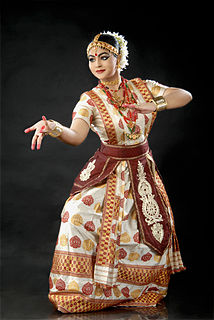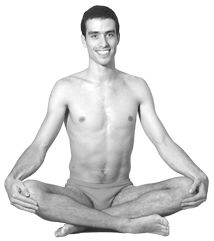Related Research Articles

Patañjali, also called Gonardiya, or Gonikaputra, was a sage in Ancient India. Very little is known about him, and no one knows exactly when he lived. It is estimated from analysis of his works that it was between the 4th and 5th centuries CE.

Yoga is a group of physical, mental, and spiritual practices or disciplines which originated in ancient India and aim to control (yoke) and still the mind, recognizing a detached witness-consciousness untouched by the mind (Chitta) and mundane suffering (Duḥkha). There is a wide variety of schools of yoga, practices, and goals in Hinduism, Buddhism, and Jainism, and traditional and modern yoga is practiced worldwide.
Buddhi refers to the intellectual faculty and the power to "form and retain concepts, reason, discern, judge, comprehend, understand".

The Yoga Sutras of Patañjali is a collection of Sanskrit sutras (aphorisms) on the theory and practice of yoga - 195 sutras and 196 sutras. The Yoga Sutras was compiled in the early centuries CE, by the sage Patanjali in India who synthesized and organized knowledge about yoga from much older traditions.

Sattriya, or Sattriya Nritya, is a major Indian classical dance. It is a dance-drama performance art with origins in the Krishna-centered Vaishnavism monasteries of Assam, and attributed to the 15th century Bhakti movement scholar and saint Mahapurush Srimanta Sankardev.

Japa is the meditative repetition of a mantra or a divine name. It is a practice found in Hinduism, Jainism, Sikhism, and Buddhism, with parallels found in other religions.

Dance in India comprises numerous styles of dances, generally classified as classical or folk. As with other aspects of Indian culture, different forms of dances originated in different parts of India, developed according to the local traditions and also imbibed elements from other parts of the country.

The Manipuri Dance, also referred to as the ManipuriRaas Leela, is one of the eight major Indian classical dance forms, originating from the state of Manipur. The dance form is imbued with the devotional themes of Madhura Raas of Radha-Krishna and characterised by gentle eyes and soft peaceful body movements. The facial expressions are peaceful mostly expressing Bhakti Rasa or the emotion of devotion, no matter if a dancer is Hindu or not. The dance form is based on Hindu Shastras of Vaishnavism and is exclusively attached to the worship of Radha Krishna. It is a portrayal of the dance of divine love of Lord Krishna with Radha and the cowherd damsels of Vrindavan, famously known as the Raas Leela.

Swami Rama Tirthapronunciation (help·info), also known as Ram Soami, was an Indian teacher of the Hindu philosophy of Vedanta. He was among the first notable teachers of Hinduism to lecture in the United States, travelling there in 1902, preceded by Swami Vivekananda in 1893 and followed by Paramahansa Yogananda in 1920. During his American tours Swami Rama Tirtha spoke frequently on the concept of 'practical Vedanta' and education of Indian youth. He proposed bringing young Indians to American universities and helped establish scholarships for Indian students.

Gheranda Samhita is a Sanskrit text of Yoga in Hinduism. It is one of the three classic texts of hatha yoga, and one of the most encyclopedic treatises in yoga. Fourteen manuscripts of the text are known, which were discovered in a region stretching from Bengal to Rajasthan. The first critical edition was published in 1933 by Adyar Library, and the second critical edition was published in 1978 by Digambarji and Ghote. Some of the Sanskrit manuscripts contain ungrammatical and incoherent verses, and some cite older Sanskrit texts.
Motilal Banarsidass Publishing House (MLBD) is an Indian publishing house, founded in Delhi, India in 1903. It publishes and distributes serials, monographs, and scholarly publications on Asian religions, philosophy, history, culture, arts, architecture, archaeology, language, literature, linguistics, musicology, mysticism, yoga, tantra, occult, medicine, astronomy, astrology.

Sukhasana, easy pose, is a simple cross-legged sitting asana in hatha yoga, sometimes used for meditation in both Buddhism and Hinduism.

The Sritattvanidhi is a treatise written in the 19th century in Karnataka on the iconography and iconometry of divine figures in South India. One of its sections includes instructions for, and illustrations of, 122 hatha yoga postures.

Neminatha, also known as Nemi and Arishtanemi, is the twenty-second tirthankara (ford-maker) in Jainism. Along with Mahavira, Parshvanatha and Rishabhanatha, Neminatha is one of the twenty four tirthankaras who attract the most devotional worship among the Jains.
Kaivalya, is the ultimate goal of aṣṭāṅga yoga and means "solitude", "detachment" or "isolation", a vrddhi-derivation from kevala "alone, isolated". It is the isolation of purusha from prakṛti, and liberation from rebirth, i.e., Moksha. Kaivalya-Mukti is described in some Upanishads, such as Muktika and Kaivalya as the most superior form of Moksha which can grant liberation both within this life, as Jivanmukti, and after death, as Videhamukti.
Kadungon was a Pandya king of early historic south India. Kadung + kon or ko (king) meaning "the great king" in tamil. He was also referred as Thennavan. He is chiefly remembered for reviving the Pandya dynastic power in south India. Along with the Pallava king Simhavishnu, he is credited with ending the Kalabhra rule, marking the beginning of a new era in south India.

Vishnu, also known as Narayana and Hari, is one of the principal deities of Hinduism. He is the supreme being within Vaishnavism, one of the major traditions within contemporary Hinduism.

Sant Charandas was a major Hindu religious teacher in Delhi during the eighteenth century.
Yoga philosophy is one of the six major orthodox schools of Hinduism, though it is only at the end of the first millennium CE that Yoga is mentioned as a separate school of thought in Indian texts, distinct from Samkhya. Ancient, medieval and most modern literature often refers to Yoga-philosophy simply as Yoga, A systematic collection of ideas of Yoga is found in the Yoga Sutras of Patanjali, a key text of Yoga which has influenced all other schools of Indian philosophy.
The Bhadanakas was a kingdom ruled over a wide area in the 11th and 12th centuries. The Bhadanakas mainly resided in Mathura, Alwar, Bharatpur, Dholpur, Karauli region. According to historian Dasharatha Sharma, when King Prithviraj Chauhan of Shakumbhari attacked Bhadanakas, at that time on the eastern border of this state was the Gwalior state of Chambal river in the northeastern direction its boundaries were up to Yamuna river and Kannauj state of Gahadwals.
References
- 1 2 3 4 "Family Tree: Satya Prakash Bahadur", TribalPages.com, archived from the original on 31 January 2018
- 1 2 The Poems of Suradusa by Sūradāsa, Krishna Prakash Bahadur ISBN 81-7017-369-8
- ↑ https://www.academia.edu/3259791/_Allahabad_University_Alumni_Association_AUAA_Proud_Past_Alumni_Gaurav_Alma_Mator_of_Allahabad_University [ dead link ]